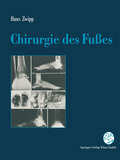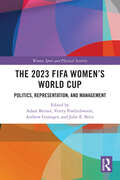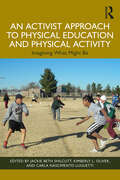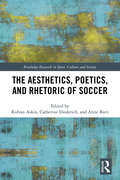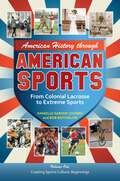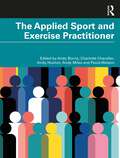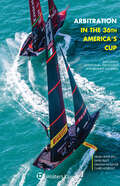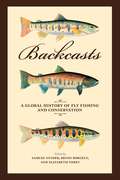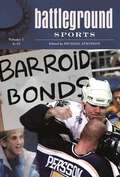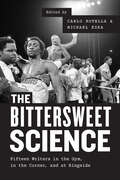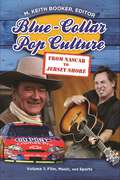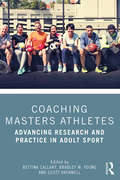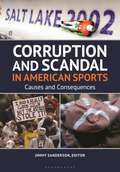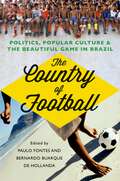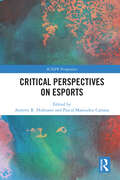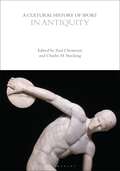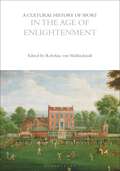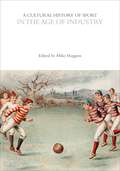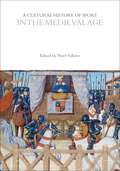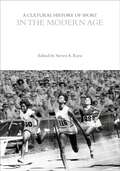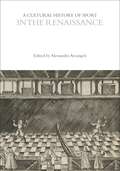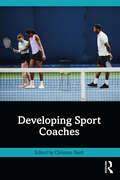- Table View
- List View
Chirurgie des Fußes
by Hans ZwippDie gesamte Sprunggelenks- und Fußchirurgie finden Sie in diesem Buch: von Komplexverletzungen des Fußes über neueste operative Techniken bis hin zu aktuellen Methoden der rekonstruktiven Fußchirurgie einschließlich der Behandlung von Fußdeformitäten.Sie erhalten eine Synopsis der gesamten Anatomie, Bio- und Pathomechanik des Fußes, veranschaulicht durch umfangreiches Bildmaterial. Spezielle klinische Tests, innovative radiologische Diagnostik wie CT, Kernspintomographie und Sonographie und die aktuellen operativen Methoden machen das Buch zu einem praktischen Ratgeber für alle Fragen der Traumatologie und restruktiven Chirurgie des Fußes.
The 2023 FIFA Women's World Cup: Politics, Representation, and Management (Women, Sport and Physical Activity)
This book offers a critical examination of the 2023 FIFA Women’s World Cup, being held in Australia and New Zealand. Drawing on perspectives from sociology, history, political science and management, it sheds new light on the development of women’s soccer and on women’s sport more broadly. The book examines the politics of the build-up to the tournament, including the bidding process, as well as how the tournament has been represented in the media, the governance structures of the tournament itself, and policy proposals designed to leave an enduring legacy for women and girls in sport. The 2023 FIFA Women’s World Cup is the first Women’s World Cup to be held in the Southern Hemisphere and the first to be held with an expanded 32-team format. This book shows why the 2023 FIFA Women’s World Cup represents a unique opportunity to enhance our understanding of women’s football, gender-oriented sport development initiatives and strategies, national sport policy and programming, and the management of international sporting events. This book is fascinating reading for any student, researcher or practitioner with an interest in sport development, sport management, sport policy, sport sociology, event management, gender studies, political science, or the relationship between sport and wider society.
An Activist Approach to Physical Education and Physical Activity: Imagining What Might Be
This timely and diverse collection offers perspectives on engaging people in physical activity utilizing the Activist Approach. This approach facilitates interest, motivation, and learning in physical education by focusing on student-centered pedagogy, embodiment, inquiry-based education, and listening and responding to students over time. The resource collates experts and beginners who have used the Activist Approach to incorporate participants’ interests, motivation, and learning needs and maintain student voices in physical activity environments. Chapters center around three broad areas of the Activist Approach: 1) physical education settings, 2) physical activity settings, and 3) teachers’ experiences of learning to use an Activist Approach in physical education and physical activity. Contributors from around the world discuss challenges and benefits experienced, issues of equity and justice and what people gained and gave up by using the approach. Focusing on key areas in physical education settings, dance, sport, and physical activity settings, and PE teacher education and professional development, this book offers crucial, critical perspectives on how to meet people’s physical activity needs.
The Aesthetics, Poetics, and Rhetoric of Soccer (Routledge Research in Sport, Culture and Society)
Soccer has long been known as 'the beautiful game'. This multi-disciplinary volume explores soccer, soccer culture, and the representation of soccer in art, film, and literature, using the critical tools of aesthetics, poetics, and rhetoric. Including international contributions from scholars of philosophy, literary and cultural studies, linguistics, art history, and the creative arts, this book begins by investigating the relationship between beauty and soccer and asks what criteria should be used to judge the sport’s aesthetic value. Covering topics as diverse as humor, national identity, style, celebrity, and social media, its chapters examine the nature of fandom, the role of language, and the significance of soccer in contemporary popular culture. It also discusses what one might call the ‘stylistics’ of soccer, analyzing how players, fans, and commentators communicate on and off the pitch, in the press, on social media, and in wider public discourse. The Aesthetics, Poetics, and Rhetoric of Soccer makes for fascinating reading for anybody with an interest in sport, culture, literature, philosophy, linguistics, and society.
American History through American Sports [3 volumes]: From Colonial Lacrosse to Extreme Sports [3 volumes]
Filled with insightful analysis and compelling arguments, this book considers the influence of sports on popular culture and spotlights the fascinating ways in which sports culture and American culture intersect.This collection blends historical and popular culture perspectives in its analysis of the development of sports and sports figures throughout American history. American History through American Sports: From Colonial Lacrosse to Extreme Sports is unique in that it focuses on how each sport has transformed and influenced society at large, demonstrating how sports and popular culture are intrinsically entwined and the ways they both reflect larger societal transformations. The essays in the book are wide-ranging, covering topics of interest for sports fans who enjoy the NFL and NASCAR as well as those who like tennis and watching the Olympics. Many topics feature information about specific sports icons and favorite heroes. Additionally, many of the topics' treatments prompt engagement by purposely challenging the reader to either agree or disagree with the author's analysis.
The Applied Sport and Exercise Practitioner
The Applied Sport and Exercise Practitioner is designed to help all developing sport and exercise practitioners navigate the world of applied work. This book explores conceptual issues surrounding applied practice such as the identity and role of the applied practitioner, professional ethics and how to be part of a multi-disciplinary team. Using a cross disciplinary approach, it brings together the challenges and experiences of sport and exercise practitioners. This book links theoretical ideas with actual practice and compares issues across disciplines and domains. Each chapter includes case studies of contemporary issues from practitioners working in different environments and with diverse populations. Important topics such as insurance, data protection, ethic and soft skills are also discussed. The Applied Sport and Exercise Practitioner is key reading for graduate students and practitioners interested in improving their practice and careers.
Arbitration in the 36th America's Cup: Including Additional Previously Unpublished Material
More than the most prestigious regatta and match race in the sport of sailing, the America’s Cup is a test of boat design, sail design, and management skills. It is not surprising that its passionate skippers, builders, and managers often become embroiled in disputes. Recognizing this, and the need to deal quickly and professionally with any divergency, an arbitration panel has become an established part of the Cup’s organization. This book—the fifth of a series that over time constitutes a unique corpus of decisions rendered over more than twenty years—compiles all the directions and decisions issued by the 36th America’s Cup Arbitration Panel in the context of the nineteen cases submitted to it, as well as all supporting documents elucidating the context in which the decisions were issued. In addition to all the decisions, the following are also included: <p style="margin-bottom:0in;margin-bottom:.0001pt;mso-line-height-alt: 10.0pt" class="MsoBodyText"> the Protocol of the 36th America’s Cup and amendments made thereto; the 36th America’s Cup Arbitration Panel Rules of Procedure; applicable versions of the World Sailing Racing Rules, the AC75 Class Rule, and the so-called Prada Cup Conditions and Match Conditions; previously unpublished documents related to proceedings which have led to the amendment and/or interpretation of the Deed of Gift by the Supreme Court of the State of New York; and previously unpublished court-related material pertaining to the key Mercury Bay case (1987-1990). An extensive and valuable introduction provides detailed historical and factual context. Expert commentary addresses issues of special interest decided by the 36th America’s Cup Arbitration Panel, including privileged insight into the previously undocumented dispute resolution during the 35th America’s Cup (2013-2017) and the World Intellectual Property Organization’s Electronic Case Management Facility (ECAF). A table containing a summary of the subject matter of each decision and a keyword index help find which argument is dealt with in which decision. <p style="margin-bottom:0in;margin-bottom:.0001pt;mso-line-height-alt: 10.0pt" class="MsoBodyText"> Because arbitration plays a key role in this context, and because what happens in the America's Cup is of general interest to the sport and arbitration communities, this book’s many insights into the kinds of issues that fuel disputes in sports events offer a significant extension of the knowledge base available to lawyers, arbitrators, and scholars in several branches of law and legal practice.
Backcasts: A Global History of Fly Fishing and Conservation
“Many of us probably would be better fishermen if we did not spend so much time watching and waiting for the world to become perfect.”-Norman Maclean Though Maclean writes of an age-old focus of all anglers—the day’s catch—he may as well be speaking to another, deeper accomplishment of the best fishermen and fisherwomen: the preservation of natural resources. Backcasts celebrates this centuries-old confluence of fly fishing and conservation. However religious, however patiently spiritual the tying and casting of the fly may be, no angler wishes to wade into rivers of industrial runoff or cast into waters devoid of fish or full of invasive species like the Asian carp. So it comes as no surprise that those who fish have long played an active, foundational role in the preservation, management, and restoration of the world’s coldwater fisheries. With sections covering the history of fly fishing; the sport’s global evolution, from the rivers of South Africa to Japan; the journeys of both native and nonnative trout; and the work of conservation organizations such as the Federation of Fly Fishers and Trout Unlimited, Backcasts casts wide. Highlighting the historical significance of outdoor recreation and sports to conservation in a collection important for fly anglers and scholars of fisheries ecology, conservation history, and environmental ethics, Backcasts explores both the problems anglers and their organizations face and how they might serve as models of conservation—in the individual trout streams, watersheds, and landscapes through which these waters flow.
Battleground: [2 volumes] (Battleground Series)
Mega-events like the Olympics, the World Cup of soccer, the World Series of baseball, cycling's Tour de France, and the Super Bowl draw our attention to the deep cultural significance of sport and its role in fostering social bonds. Yet when it comes to sport, there is no shortage of debate: stereotypes regarding sexuality, race, gender, and children have been hotly contested by critics for over 40 years. Even today, sport is one of the very few socially accepted sites of violence, intense competition and controlled forms of social disorder. Battleground: Sports presents the 100 most contentious public and private controversies of the sports world. Highlighted throughout are debates surrounding ethnicity, gender, sexuality, and social identity, sports fan behavior, as well as the role of governments and corporations.Engaging and accessible to a wide variety of readers, this fascinating reference illustrates how sports controversies reflect the historically enduring and changing nature of our broader cultures, and the social battles we engage on a day-to-day basis surrounding the struggles for equality, debates about social violence, the ethics of competition, the politics of civic life, the creation of global communities, and the State's role in protecting citizens. Entries contain an array of thoughtful perspectives on historic and current controversies, and allow readers to formulate their own conclusions. Enhanced with a timeline, a thorough guide of print and electronic resources for high school and undergraduate student research, this one-stop reference goes beyond the newspaper headlines to provide readers with a guide map for understanding what sport controversies teach us about our culture and ourselves.
Bicycle (Large Print)
This bicycle is shown from the side. There is a locator dot shown, which will be at the top left of the page when the image is the right way up. The handlebars are on the top left of the page. They have been turned to face you so both handle grips can be found. The handlebars are connected to the front wheel via the frame. Connected to the frame in the top right of the image is the saddle, below this are two pedals and a chain which links to the rear wheel on the right.
Bicycle (UEB Contracted)
This bicycle is shown from the side. There is a locator dot shown, which will be at the top left of the page when the image is the right way up. The handlebars are on the top left of the page. They have been turned to face you so both handle grips can be found. The handlebars are connected to the front wheel via the frame. Connected to the frame in the top right of the image is the saddle, below this are two pedals and a chain which links to the rear wheel on the right.
Bicycle (UEB uncontracted)
This bicycle is shown from the side. There is a locator dot shown, which will be at the top left of the page when the image is the right way up. The handlebars are on the top left of the page. They have been turned to face you so both handle grips can be found. The handlebars are connected to the front wheel via the frame. Connected to the frame in the top right of the image is the saddle, below this are two pedals and a chain which links to the rear wheel on the right.
The Bittersweet Science: Fifteen Writers in the Gym, in the Corner, and at Ringside
Weighing in with a balance of the visceral and the cerebral, boxing has attracted writers for millennia. Yet few of the writers drawn to it have truly known the sport—and most have never been in the ring. Moving beyond the typical sentimentality, romanticism, or cynicism common to writing on boxing, The Bittersweet Science is a collection of essays about boxing by contributors who are not only skilled writers but also have extensive firsthand experience at ringside and in the gym, the corner, and the ring itself. Editors Carlo Rotella and Michael Ezra have assembled a roster of fresh voices, ones that expand our understanding of the sport’s primal appeal. The contributors to The Bittersweet Science—journalists, fiction writers, fight people, and more—explore the fight world's many aspects, considering boxing as both craft and business, art form and subculture. From manager Charles Farrell’s unsentimental defense of fixing fights to former Golden Glover Sarah Deming’s complex profile of young Olympian Claressa Shields, this collection takes us right into the ring and makes us feel the stories of the people who are drawn to—or sometimes stuck in—the boxing world. We get close-up profiles of marquee attractions like Bernard Hopkins and Roy Jones Jr., as well as portraits of rising stars and compelling cornermen, along with first-person, hands-on accounts from fighters’ points of view. We are schooled in not only how to hit and be hit, but why and when to throw in the towel. We experience the intimate immediacy of ringside as well as the dim back rooms where the essentials come together. And we learn that for every champion there’s a regiment of journeymen, dabblers, and anglers for advantage, for every aspiring fighter, a veteran in painful decline. Collectively, the perspectives in The Bittersweet Science offer a powerful in-depth picture of boxing, bobbing and weaving through the desires, delusions, and dreams of boxers, fans, and the cast of managers, trainers, promoters, and hangers-on who make up life in and around the ring. Contributors: Robert Anasi, Brin-Jonathan Butler, Donovan Craig, Sarah Deming, Michael Ezra, Charles Farrell, Rafael Garcia, Gordon Marino, Louis Moore, Gary Lee Moser, Hamilton Nolan, Gabe Oppenheim, Carlo Rotella, Sam Sheridan, and Carl Weingarten.
Blue-Collar Pop Culture [2 volumes]: From NASCAR to Jersey Shore [2 volumes]
From television, film, and music to sports, comics, and everyday life, this book provides a comprehensive view of working-class culture in America.The terms "blue collar" and "working class" remain incredibly vague in the United States, especially in pop culture, where they are used to express and connote different things at different times. Interestingly, most Americans are, in reality, members of the working class, even if they do not necessarily think of themselves that way. Perhaps the popularity of many cultural phenomena focused on the working class can be explained in this way: we are endlessly fascinated by ourselves.Blue-Collar Pop Culture: From NASCAR to Jersey Shore provides a sophisticated, accessible, and entertaining examination of the intersection between American popular culture and working-class life in America. Covering topics as diverse as the attacks of September 11th, union loyalties, religion, trailer parks, professional wrestling, and Elvis Presley, the essays in this two-volume work will appeal to general readers and be valuable to scholars and students studying American popular culture.
Coaching Masters Athletes: Advancing Research and Practice in Adult Sport
This book is a foundational resource for all coaches and student coaches who are, or who plan to be, working with Masters athletes. This athletic cohort typically includes adults over the age of 35 years who are registered for sport programs/events, and who invest in training to improve themselves for competitions that range from recreational to championship caliber. As the boom in Masters sport continues worldwide, coaches are increasingly tasked with the development and support of adults’ quality sport experiences, and the implementation of strategies to foster skill acquisition and to facilitate their pursuit of competitive goals. This book presents what is different about coaching Masters athletes and prompts coaches to expand their scope of practice beyond traditional knowledge associated with youth or younger adult cohorts. It is essential for coaches to understand the psychological and social considerations that are unique to coaching adult sports-persons and Masters athletes, and that can be adapted to adults whose training and preparation for competition is quite varied. Coaching Masters Athletes: Advancing Research and Practice in Adult Sport explores the research and practice specific to planning to coach Masters athletes and divulges what is known about distinctive considerations for delivering coaching interventions to this cohort, expanding on coaches’ abilities to influence adults’ personal development, as well as their own coach education through Masters Sport. Readers and students of Coaching, Physical Activity, Health Psychology, Sport Leadership and Exercises Science will gain valuable applied perspectives grounded in best practice research on how to coach one of the fastest-growing sporting cohorts, to promote quality adult sport, and to keep adult sports-persons engaged and active as they age.
Corruption and Scandal in American Sports: Causes and Consequences
Scandals about cheating and corruption have dogged amateur and professional sports in the United States since the nation's earliest days. This work examines the most infamous and consequential of these controversies and scandals both on and off the field.Authoritative Individual essays tackle notorious events in popular American sports ranging from the 1919 Black Sox scandal to revelations of sign stealing by the Houston Astros throughout their 2020 championship season, with stops in between to survey horrific sex abuse scandals at Penn State, Baylor, and Michigan State; steroid and drug scandals that brought down once-admired athletes like Mark McGwire and Lance Armstrong; and cheating/betting controversies that tainted individual players (Pete Rose), teams (Boston College, New England Patriots), and entire leagues (including the Little League World Series in 2001). But this work does more than just recount these events; it will also examine the cultural and economic pressures and forces that contributed to these events, as well as the lessons learned and steps taken (if any) to enact reform and help the sport recover.
The Country of Football: Politics, Popular Culture, and the Beautiful Game in Brazil
Brazil has done much to shape football/soccer, but how has soccer shaped Brazil? Despite the political and social importance of the beautiful game to the country, the subject has hitherto received little attention. This book presents groundbreaking work by historians and researchers from Brazil, the United States, Britain and France, who examine the political significance, in the broadest sense, of the sport in which Brazil has long been a world leader. The authors consider questions such as the relationship between soccer, the workplace and working class culture; the formation of Brazilian national identity; race relations; political and social movements; and the impact of the sport on social mobility. Contributions to the book range in time from the late nineteenth century, when the British first introduced the sport to Brazil, to the present day, as the 'country of soccer' prepares itself to host the 2014 World Cup, painting a vivid picture of the many ways in which soccer exists and functions in Brazil, both on and off the pitch.
Critical Perspectives on Esports (ICSSPE Perspectives)
This book offers new, multidisciplinary perspectives on esports, one of the most rapidly growing sectors in the sports and leisure industries.Drawing on sociology, philosophy, education, business, economics, and sports science, this book considers the rise of esports, its impact on sports and society more widely, and the direction of travel for esports in the future. Featuring cutting-edge work from researchers in Europe, North America, and Asia, this book explores definitions of “esport” and “virtual sport,” and the philosophical basis by which we understand movement and embodiment in the context of digital gaming. It considers the health and well-being needs of esports athletes, across physical, mental, and social dimensions, as well as how nutrition and training relate to performance and injury prevention. This book also considers the economics of the esports industry and how the concept of sportification can be used to describe esports’ development, as well as the challenges and debates surrounding gender and representation in esports. A final section of this book looks at esports in education, in schools and universities, and considers the future of esports for a generation of digital natives.This book makes a useful contribution to the growing body of knowledge on esports and should be a thought-provoking read for anybody with an interest in sports studies, gaming, or the impact of technology on wider society.
A Cultural History of Sport in Antiquity (The Cultural Histories Series)
A Cultural History of Sport in Antiquity covers the period 800 BCE to 600 CE. From the founding of the Olympics and Rome's celebratory games, sport permeated the cultural life of Greco-Roman antiquity almost as it does our own. Gymnasiums, public baths, monumental arenas, and circuses for chariot racing were constructed, and athletic contests proliferated. Sports-themed household objects were very popular, whilst the exploits of individual athletes, gladiators, and charioteers were immortalized in poetry, monuments, and the mosaic floors of the wealthy. This rich sporting culture attests to the importance of leisure among the middle and upper classes of the Greco-Roman world, but by 600 CE rising costs, barbarian invasions, and Christianity had swept it all away.The 6 volume set of the Cultural History of Sport presents the first comprehensive history from classical antiquity to today, covering all forms and aspects of sport and its ever-changing social, cultural, political, and economic context and impact. The themes covered in each volume are the purpose of sport; sporting time and sporting space; products, training and technology; rules and order; conflict and accommodation; inclusion, exclusion and segregation; minds, bodies and identities; representation.Paul Christesen is Professor at Dartmouth College, USA. Charles Stocking is Associate Professor at Western University, Canada.Volume 1 in the Cultural History of Sport setGeneral Editors: Wray Vamplew, Mark Dyreson, and John McClelland
A Cultural History of Sport in the Age of Enlightenment (The Cultural Histories Series)
A Cultural History of Sport in the Age of Enlightenment covers the period 1650 to 1800, a period often seen as a time of decline in sporting practice and literature. In fact, a rich sporting culture existed and sports were practised by both men and women at all levels of society. The Enlightenment called into question many of the earlier notions of religion, gender, and rank which had previously shaped sporting activities and also initiated the commercialization, professionalization and associativity which were to define modern sport. The 6 volume set of the Cultural History of Sport presents the first comprehensive history from classical antiquity to today, covering all forms and aspects of sport and its ever-changing social, cultural, political, and economic context and impact. The themes covered in each volume are the purpose of sport; sporting time and sporting space; products, training and technology; rules and order; conflict and accommodation; inclusion, exclusion and segregation; minds, bodies and identities; representation. Rebekka von Mallinckrodt is Professor at the University of Bremen, Germany. Volume 4 in the Cultural History of Sport set General Editors: Wray Vamplew, Mark Dyreson, and John McClelland
A Cultural History of Sport in the Age of Industry (The Cultural Histories Series)
A Cultural History of Sport in the Age of Industry covers the period 1800 to 1920. Over this period, sport become increasingly global, some sports were radically altered, sports clubs proliferated, and new team games - such as baseball, basketball and the various forms of football - were created, codified, commercialized, and professionalized. Yet this was also an age of cultural and political tensions, when issues around the role of women, social class, ethnicity and race, imperial relationships, nation-building, and amateur and professional approaches were all shaping sport. At the same time, increasing urbanization, population, real wages and leisure time drove demand for sport ever higher, and the institutionalization and regulation of sport accelerated. The 6 volume set of the Cultural History of Sport presents the first comprehensive history from classical antiquity to today, covering all forms and aspects of sport and its ever-changing social, cultural, political, and economic context and impact. The themes covered in each volume are the purpose of sport; sporting time and sporting space; products, training and technology; rules and order; conflict and accommodation; inclusion, exclusion and segregation; minds, bodies and identities; representation. Mike Huggins is Emeritus Professor at the University of Cumbria, UK. Volume 5 in the Cultural History of Sport set General Editors: Wray Vamplew, Mark Dyreson, and John McClelland
A Cultural History of Sport in the Medieval Age (The Cultural Histories Series)
A Cultural History of Sport in the Medieval Age covers the period 600 to 1450. Lacking any viable ancient models, sport evolved into two distinct forms, divided by class. Male and female aristocrats hunted and knights engaged in jousting and tournaments, transforming increasingly outdated modes of warfare into brilliant spectacle. Meanwhile, simpler sports provided recreational distraction from the dangerously unsettled conditions of everyday life. Running, jumping, wrestling, and many ball games - soccer, cricket, baseball, golf, and tennis – had their often violent beginnings in this period. The 6 volume set of the Cultural History of Sport presents the first comprehensive history from classical antiquity to today, covering all forms and aspects of sport and its ever-changing social, cultural, political, and economic context and impact. The themes covered in each volume are the purpose of sport; sporting time and sporting space; products, training and technology; rules and order; conflict and accommodation; inclusion, exclusion and segregation; minds, bodies and identities; representation. Noel Fallows is Distinguished Research Professor at the University of Georgia, USA. Volume 2 in the Cultural History of Sport set General Editors: Wray Vamplew, Mark Dyreson, and John McClelland
A Cultural History of Sport in the Modern Age (The Cultural Histories Series)
A Cultural History of Sport in the Modern Age covers the period 1920 to today. Over this time, world-wide participation in sport has been shaped by economic developments, communication and transportation innovations, declining racism, diplomacy, political ideologies, feminization, democratization, as well as increasing professionalization and commercialization. Sport has now become both a global cultural force and one of the deepest ways in which individual nations express their myths, beliefs, values, traditions and realities. The 6 volume set of the Cultural History of Sport presents the first comprehensive history from classical antiquity to today, covering all forms and aspects of sport and its ever-changing social, cultural, political, and economic context and impact. The themes covered in each volume are the purpose of sport; sporting time and sporting space; products, training and technology; rules and order; conflict and accommodation; inclusion, exclusion and segregation; minds, bodies and identities; representation. Steven A. Riess is Professor Emeritus at Northeastern Illinois University, USA. Volume 6 in the Cultural History of Sport set General Editors: Wray Vamplew, Mark Dyreson, and John McClelland
A Cultural History of Sport in the Renaissance (The Cultural Histories Series)
A Cultural History of Sport in the Renaissance covers the period 1450 to 1650. Outwardly, Renaissance sports resembled their medieval forebears, but the incorporation of athletics into the educational curriculum signalled a change. As part of the scientific revolution, sport now became the object of intellectual analysis. Numerous books were written on the medical benefits of sport and on the best way to joust, fence, train horses and ride, play ball games, swim, practice archery, wrestle, or become an acrobat. Sport became the visible sign of the mind's control over the physical body, such control often becoming an end in itself with some sports shaped more by decorum than exercise. The 6 volume set of the Cultural History of Sport presents the first comprehensive history from classical antiquity to today, covering all forms and aspects of sport and its ever-changing social, cultural, political, and economic context and impact. The themes covered in each volume are the purpose of sport; sporting time and sporting space; products, training and technology; rules and order; conflict and accommodation; inclusion, exclusion and segregation; minds, bodies and identities; representation. Alessandro Arcangeli is Associate Professor at the University of Verona, Italy. Volume 3 in the Cultural History of Sport set General Editors: Wray Vamplew, Mark Dyreson, and John McClelland
Developing Sport Coaches
Evolving from the concept of coach education, which is generally accepted to be the more formal, didactic mode of transmitting information to coaches and prospective coaches, coach development is a relatively new field of research and practice. Developing Sport Coaches is a new text that supports the holistic longterm development of sport coaches as well as help aid existing sport coaches to understand their development. Research in coach learning and coach education has raised important questions about the effectiveness, relevance and value placed on traditional coach education by sport coaches in relation to their practice. The dissatisfaction expressed by many coaches, at all stages of coaching practice, has led to the inception of coach development. This text enables coach development to be studied in higher education institutions as well as enabling organisations to embed coach developers within their organisations. Written for the sport coaching and expanding coach development market, this book will be used by higher education institutions students as both a core and additional text to advance research and knowledge in this area. At the same time, this book is also a useful reading for practising sport coaches, coach developers and organisations who are currently examining their structures and processes to move their coaching provision from a formal coach education delivery to a more bespoke offering.
